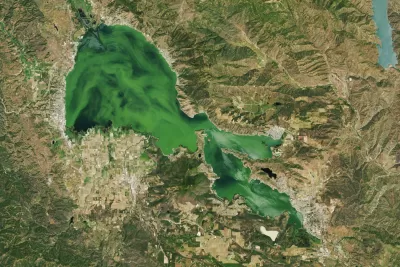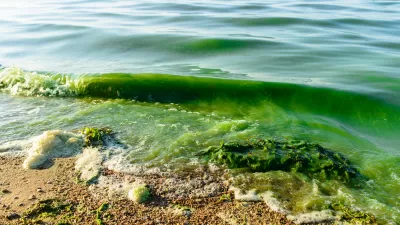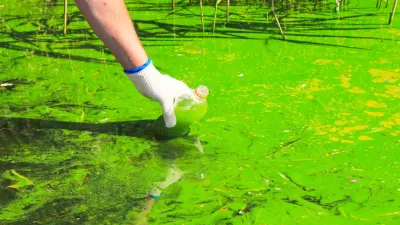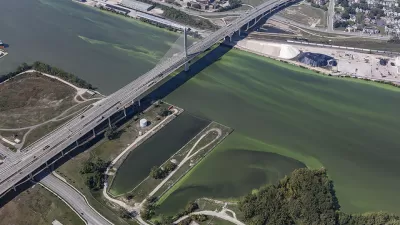A potentially toxic algal bloom has turned Clear Lake in Northern California bright green, fed by increased runoff from human activity.

“Clear Lake, one of California’s oldest and most-visited lakes, is not so clear anymore after an algal bloom turned the water cloudy and green,” reports Terry Castleman for the Los Angeles Times. Located about 60 miles north of the San Francisco Bay, the 43,000-acre freshwater lake is a popular destination for boaters, fishers, and swimmers, but those activities will likely be affected for weeks to come.
The bloom may be comprised of blue-green algae, also known as cyanobacteria, which produce a toxin that can irritate the skin and cause liver and kidney damage. According to Nasa, “Algal blooms have been common in Clear Lake’s long history, but have grown more common with human activity in the last century,” including runoff from nearby farms, vineyards, faulty septic systems, gravel mines, and an abandoned open-pit mercury mine, as well as from nonnative carp stirring up the nutrients in the lake bed’s sediment.
Cyanobacteria is the same type of toxic algae that has bloomed extensively in Lake Erie over the last several years, most notably in 2014 when residents in Toledo, Ohio, were unable to drink, cook with, or brush their teeth with water for three days. States across the country are dealing with algae blooms due to nutrient run-off, impacting local water quality and water-based tourism, including Cape Cod.
FULL STORY: Shocking before-and-after photos show California’s famed Clear Lake turn bright green

Alabama: Trump Terminates Settlements for Black Communities Harmed By Raw Sewage
Trump deemed the landmark civil rights agreement “illegal DEI and environmental justice policy.”

Planetizen Federal Action Tracker
A weekly monitor of how Trump’s orders and actions are impacting planners and planning in America.

The 120 Year Old Tiny Home Villages That Sheltered San Francisco’s Earthquake Refugees
More than a century ago, San Francisco mobilized to house thousands of residents displaced by the 1906 earthquake. Could their strategy offer a model for the present?

LA’s Tree Emergency Goes Beyond Vandalism
After a vandal destroyed dozens of downtown LA trees, Mayor Karen Bass vowed to replace them. Days later, she slashed the city’s tree budget.

Sacramento Leads Nation With Bus-Mounted Bike Lane Enforcement Cameras
The city is the first to use its bus-mounted traffic enforcement system to cite drivers who park or drive in bike lanes.

Seattle Voters Approve Social Housing Referendum
Voters approved a corporate tax to fund the city’s housing authority despite an opposition campaign funded by Amazon and Microsoft.
Urban Design for Planners 1: Software Tools
This six-course series explores essential urban design concepts using open source software and equips planners with the tools they need to participate fully in the urban design process.
Planning for Universal Design
Learn the tools for implementing Universal Design in planning regulations.
Ada County Highway District
Clanton & Associates, Inc.
Jessamine County Fiscal Court
Institute for Housing and Urban Development Studies (IHS)
City of Grandview
Harvard GSD Executive Education
Toledo-Lucas County Plan Commissions
Salt Lake City
NYU Wagner Graduate School of Public Service





























